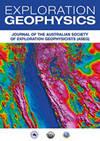How magnetic susceptibilities measured on outcrops can be used for modelling (and constraining inversions of) aeromagnetic data
IF 0.8
4区 地球科学
Q4 GEOCHEMISTRY & GEOPHYSICS
引用次数: 1
Abstract
Magnetic susceptibilities measured on outcrop are often assumed to be reasonable values to use when modelling aeromagnetic data. We have undertaken two exercises to understand how useful these measurements are for magnetic modelling. Estimates of apparent magnetic susceptibility can also be derived from aeromagnetic data by mathematical transformation if certain stringent conditions are satisfied. In the first exercise comparison of these two sets of values shows that when the measured values are below 1 × 10−3 SI, there is no correlation between the measured and apparent values. Above this value, the measured and estimated values agree to within a factor of 10, so these measured values can only be used as very rough constraints. In the second exercise, a database of outcrop measured magnetic susceptibilities was used to estimate a mean value for each lithology. When the mean of the measured values was used in our forward modelling exercise, we obtained a poor fit. However, when we inserted additional layers with larger susceptibilities that are represented on the histogram of a regional compilation of that lithology, the fit was satisfactory. In some cases, these additional layers were located in areas where there is relatively large variability in the magnetic susceptibility values measured on nearby outcrops. A large database of outcrop magnetic susceptibilities proved useful for providing a reasonable initial guess and the range of values that encompass the possible heterogeneities in each rock type.在露头上测量的磁化率如何用于航空磁数据的建模(和约束反演)
在对航磁数据进行建模时,通常认为在露头上测量的磁化率是合理的值。我们进行了两次练习,以了解这些测量对磁性建模的有用程度。如果满足某些严格条件,也可以通过数学变换从航磁数据中导出表观磁化率的估计值。在第一次练习中,这两组值的比较表明,当测量值低于1时 × 10−3 SI,测量值和表观值之间没有相关性。在该值以上,测量值和估计值在因子10内一致,因此这些测量值只能用作非常粗略的约束。在第二次演习中,使用露头测得的磁化率数据库来估计每个岩性的平均值。当在我们的正向建模练习中使用测量值的平均值时,我们获得了较差的拟合。然而,当我们插入在该岩性的区域汇编直方图上表示的具有较大易感性的附加层时,拟合是令人满意的。在某些情况下,这些附加层位于附近露头测得的磁化率值变化相对较大的区域。事实证明,露头磁化率的大型数据库有助于提供合理的初始猜测和涵盖每种岩石类型可能的非均质性的值范围。
本文章由计算机程序翻译,如有差异,请以英文原文为准。
求助全文
约1分钟内获得全文
求助全文
来源期刊

Exploration Geophysics
地学-地球化学与地球物理
CiteScore
2.30
自引率
0.00%
发文量
33
审稿时长
>12 weeks
期刊介绍:
Exploration Geophysics is published on behalf of the Australian Society of Exploration Geophysicists (ASEG), Society of Exploration Geophysics of Japan (SEGJ), and Korean Society of Earth and Exploration Geophysicists (KSEG).
The journal presents significant case histories, advances in data interpretation, and theoretical developments resulting from original research in exploration and applied geophysics. Papers that may have implications for field practice in Australia, even if they report work from other continents, will be welcome. ´Exploration and applied geophysics´ will be interpreted broadly by the editors, so that geotechnical and environmental studies are by no means precluded.
Papers are expected to be of a high standard. Exploration Geophysics uses an international pool of reviewers drawn from industry and academic authorities as selected by the editorial panel.
The journal provides a common meeting ground for geophysicists active in either field studies or basic research.
 求助内容:
求助内容: 应助结果提醒方式:
应助结果提醒方式:


